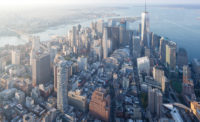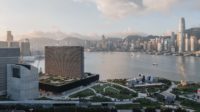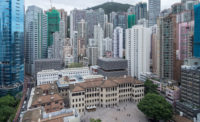The latest hotel to open in Manhattan’s rapidly gentrifying Lower East Side, the Public, has been getting a lot of attention. It is not simply because it was designed by name-brand Swiss architects Herzog & de Meuron for the high-concept hotelier Ian Schrager. And neither is it because the new, reinforced-concrete tower is distinctively glazed with slightly canted windows that give the exterior surfaces a craggy but glossy air. No. The Public’s publicity revolves around certain intimate acts enthusiastically carried out by some hotel guests and visible through those architectonic apertures. This spontaneous sex-in-the-city performance art helped make the Standard Hotel on the High Line (designed by Ennead Architects) all the talk when it opened in 2009. Are X-rated floor shows now de rigueur for ultracool caravanseries?
The neighbors are not pleased. When Schrager bought the 22,700-square-foot parcel in 2012 with the Witkoff Group, it was part of a larger site that included a subsidized rental housing project, Ten Stanton Street, whose low and moderate-income residents had used the prospective hotel’s property as a park and playground. The owner was able to sell a narrow lot to the hotel by extending the government-sponsored lease program for the housing until 2035. The apartment dwellers could stay, but they lost their open space.
With the Public, a brand Schrager initiated in Chicago in 2011, the hotelier says he wanted to offer moderately priced rooms, starting at $150 a night, to a youthful clientele that might otherwise turn to Airbnb. The 28-story mixed-use tower includes 367 guest rooms and 11 condominium apartments at the top. (The John Pawson–designed apartments, 10 of which have sold to date, at market prices, should make it all financially worthwhile.) To keep the hotel rates down, the design team made the guest rooms diminutive—generally 191 square feet—in keeping with the tiny rooms in many of Schrager’s other hotels in New York and elsewhere. He likens the cozy, white-oak bed alcoves to yacht cabins. Herzog & de Meuron partner Ascan Mergenthaler explains: “For a small floor plate, we gained more space with a bedroom niche and interlocking back-to-back bathrooms.”
Additional Content:
Jump to credits & specifications
The shift in program from hotel to condos on the 19th through 25th floors is reflected by the setback massing of the tower, along with different fenestration: the hotel’s one-window-per-room format, framed by the aluminum profile extrusions, changes to larger bands of glazing for the condos, where the concrete frame also becomes more pronounced.
Zoning for the 313-foot-high tower dictated it be pulled back 50 feet from the street, allowing landscape designer Madison Cox to create a verdant garden fronting the entrance—a surprising oasis in an area once known for gritty tenements.
Entering the hotel, you immediately encounter a bold, swooping set of stainless-steel escalators with mirror-polished rose-gold-tinted walls. The escalators divide a retail shop from a café/deli and, at the back, the Kitchen, a culinary outpost overseen by chef Jean-Georges Vongerichten. While the restaurant should attract its fair share of foodies, those who want to kick back with a Champagne can proceed on their stiletto heels or sneakers to the second-floor bars. “We try to entice people upward with a very expressive tunnel element, which replaces the monumental stair of the old grand hotels,” says Mergenthaler. The ascent takes you to the second-floor lobby, where one spacious lounge overlooks the front garden, the other, a patch of foliage at the rear.
Herzog & de Meuron’s approach to materials is expressed not only in the architecture but in the interior finishes and built-in furnishings. For example, by using wire-brushed Douglas fir plywood form-work for the exposed concrete frame, the firm animated the surfaces with a textural, grainy pattern. Its decision to cover the interior’s walls and ceilings with wire-brushed Douglas fir-larch plywood, treated for fire protection, reinforces the slightly rough-and-ready look of the concrete columns.
Against Herzog & de Meuron’s strong backdrop is a layer of comfortably modern, soigné custom furniture and objects designed by Bonetti/Kozerski Architecture and Design. The young firm also worked with Schrager to reinforce the hideaway feeling of the basement-level entertainment venue, called the Public Arts Club. Here, raw concrete, steel, black glass walls and brown leather banquettes set the downtown tone, minus the scuzziness.
The design collaborations in the making of the Public, it is safe to say, were heavily guided by Schrager’s pronounced predilections. “Ian’s a great sparring partner in developing ideas,” says Mergenthaler. Since this is the third project by Herzog & de Meuron for Schrager (the apartments at 40 Bond Street opened in 2008, while 160 Leroy Street is still in construction), the partnership is clearly clicking. Carlos Cardoso of Beyer Blinder Belle, the executive architect for the Public, also credits the well-executed construction to the sense of camaraderie among the builders and engineers.
And then there’s the neighborhood. The former working-class enclave and gateway for immigrants has been evolving for years into an artsy hot spot, with the opening of galleries, clubs, restaurants, and museums. But, as the ruggedly chic Public settles in, let’s hope it can become a welcome part of the older community. For starters, Schrager and company could fulfill its earlier promise to create a small park and playground on the land of Ten Stanton for the neighbors who lost their outdoor amenity. And after the publicity-stunt peep shows have died down, maybe the smartly crafted Public will be appreciated more for its sculptural windows than for the activities they frame.
CreditsDesign Architect: Herzog & de Meuron — Jacques Herzog, Pierre de Meuron, partners; Ascan Mergenthaler, partner in charge
Executive Architect: Beyer Blinder Belle Architects & Planners
Engineers DeSimone Consulting Engineers (structural); ADS Engineers (m/e/p/security)
Consultants Bonetti/Kozerski Architecture and Design (public interiors); Madison Cox (landscape); M. Paul Friedberg & Partners (executive landscape architect); Isometrix Lighting + Design (lead lighting designer), Fisher Marantz Stone (lighting consultants); Gilsanz Murray Steficek (facade engineering); Reg Hough Associates (concrete) |
SpecificationsHotel room windows Intercom/Wicona Escalators RimexMetals View additional credits and specifications from Herzog & de Meuron and Ian Schrager |

















Post a comment to this article
Report Abusive Comment